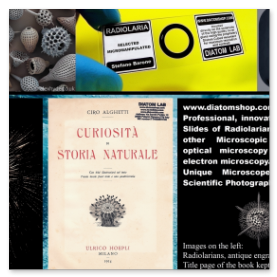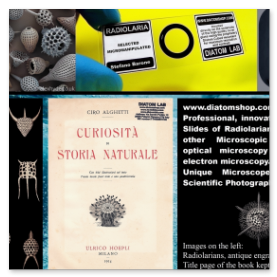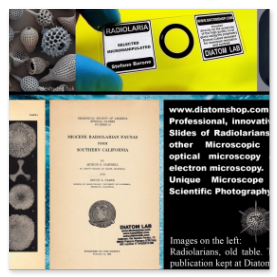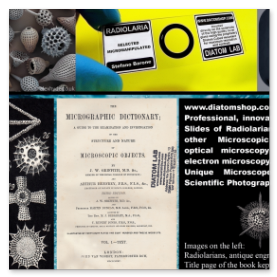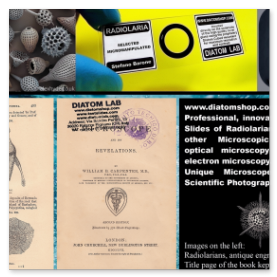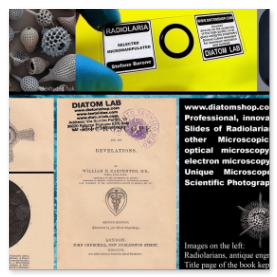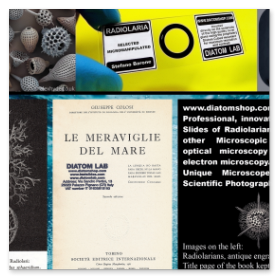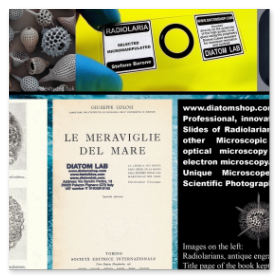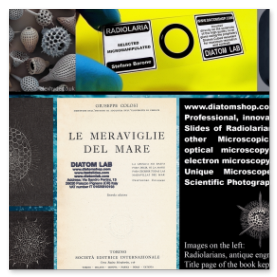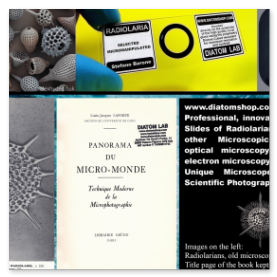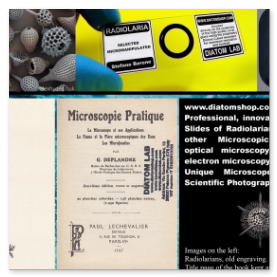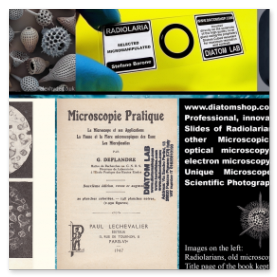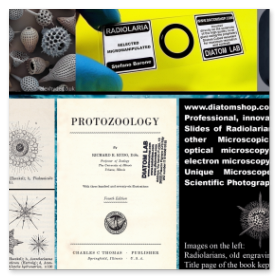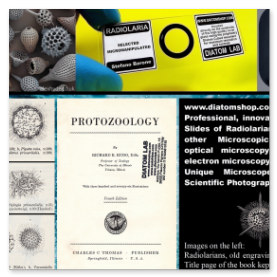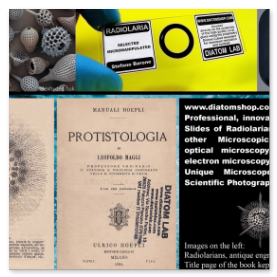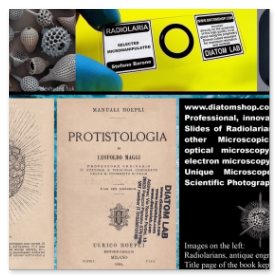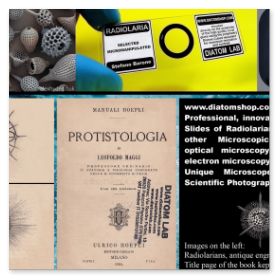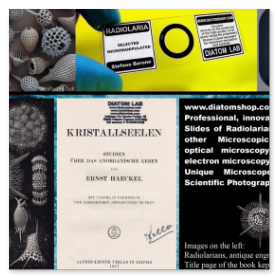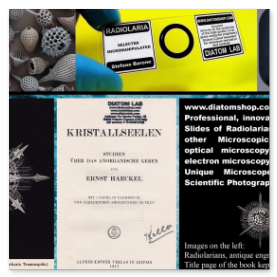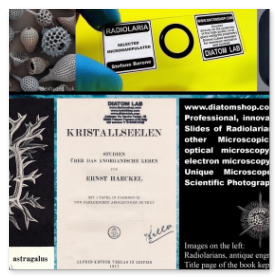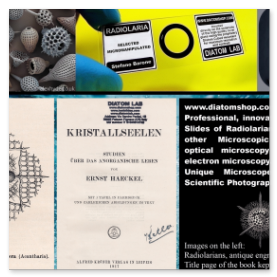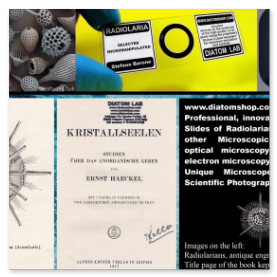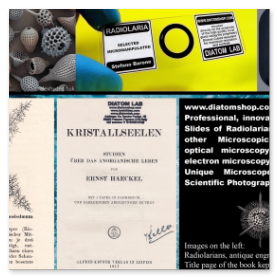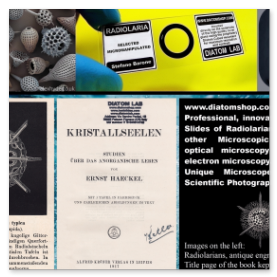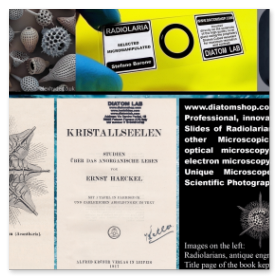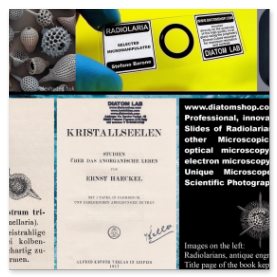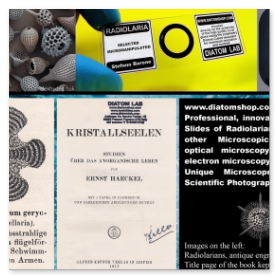Diatom Lab offers both arranged and strewn Radiolarians for sale. Only the best, cleanest, unbroken specimens are hand selected, and all slides are quality checked on our in-house Zeiss Axio Imager.A2 research microscope before shipment. Diatom Lab offers perfectly cleaned, selected Radiolarians that are micromanipulated paying attention to their ideal positioning to show off the best features. All micromanipulated Radiolarians are guaranteed to be fixed directly to the UNDERSIDE of the custom optical quality cover glass (and not as-is common, on the microscope slide) for maximum resolution and contrast! (The reason for this: microscope objective performance drops quickly noticeably as the specimen distance from the cover glass increases. Microscope objective lenses are designed to be optimally corrected for objects located immediately below the coverslip) All current and fossil Radiolarians are cleaned in our laboratory using innovative, and professional techniques. We use the proprietary PRIME MOUNTANT high refractive index microfiltered mountant with a refractive index of over 1.7 and excellent chemical stability!
Dowload the latest article that Stefano Barone has written about Radiolarians, with the introduction to his unusual psychological perspective (more works will be written in the future):
The German naturalist, artist and philosopher Ernst Haeckel (1834-1919) with the publication of his most important work, "Kunstformen der Natur" series (in English: "Art Forms in Nature") beginning in 1899, brought the intrinsic beauty of microscopic Radiolarians to the public through his scrupulous and exquisite watercolors. "Kunstformen der Natur" had a great impact on twentieth-century art and architecture and Haeckel's Radiolarians helped to show that art and science can be friends.
Radiolarians are a component of the sea zooplankton and a quote from the old book "Nature trough microscope and camera" by Richard Kerr (1909) is useful to describe their immense beauty: “When a number of these fossil forms are placed under the microscope, they will be found to be a thing of beauty and a joy for ever. It is no exaggeration to say that sermons have been preached which have been prompted or suggested by a microscopic view of these matchless and exquisitely beautiful organisms part of Nature’s building material. And why not ? Nature is the ‘ other book,’ and the more both books are thoroughly understood, the more they will be found to harmonise. I recommend the polycystina to all grades of thinkers, to scholars of every school of research, to divines, to philosophers, to teachers of youth, to leaders of thought, with the full confidence that the study of these almost invisible relics of life will impress their minds with the grandeur of Nature, the marvels of geology, the possibilities and the potentialities of mere specks of flint. And their influence is not likely to end even there".
Radiolarians are a component of the sea zooplankton and a quote from the old book "Nature trough microscope and camera" by Richard Kerr (1909) is useful to describe their immense beauty: “When a number of these fossil forms are placed under the microscope, they will be found to be a thing of beauty and a joy for ever. It is no exaggeration to say that sermons have been preached which have been prompted or suggested by a microscopic view of these matchless and exquisitely beautiful organisms part of Nature’s building material. And why not ? Nature is the ‘ other book,’ and the more both books are thoroughly understood, the more they will be found to harmonise. I recommend the polycystina to all grades of thinkers, to scholars of every school of research, to divines, to philosophers, to teachers of youth, to leaders of thought, with the full confidence that the study of these almost invisible relics of life will impress their minds with the grandeur of Nature, the marvels of geology, the possibilities and the potentialities of mere specks of flint. And their influence is not likely to end even there".
The Radiolarians are traditionally divided into four groups:
1) Acantharea (Holacanthida, Chaunacanthida, Symphyacanthida, Arthracanthida)
2) Nassellaria (under the class Polycystina)
3) Spumellaria (under the class Polycystina)
4) Phaeodarea. However Phaeodarea in molecular trees do not appear to be close relatives of the other groups, and are instead placed among the Cercozoa.
The list below represents deposits and localities of Radiolarians that are currently stocked in large amounts (the many smaller samples are not included here!):
1) Jérémie, Haiti, Samples A, B, C, D, E, F (Lower Miocene), extremely rare samples! See:
- Möller, J. D., 1892. Polycystinen-Mergel von Jérémy, Haiti. (Verzeichnis der in den Lichtdrucktafeln Möller'scher Diatomaceen-Präparate enthaltenen Arten). Wedel (Holstein) : Selbstverlag des Herausgebers, pp. 110-112, tafel 16;
- Truan y Luard, A. & Witt, O.N.,1888. Die Diatomaceen der Polycystinenkreide von Jeremie in Hayti, Westindien. Friedlander et Sohn, Berlin., 24 pp., 7 pls.;
- Riedel W. R., 1959. Oligocene and Lower Miocene Radiolaria in Tropical Pacific Sediments. Micropaleontology Vol. 5, No. 3, pp. 285-302
2) Barbados, Bath Cliff (Eocene), very rare sample! (Described in the publication: Saunders, J.B., Bernoulli, D., Mueller-Merz, E., Oberhänsli, H., Perch-Nielsen, K., Riedel, W.R., Sanfilippo, A., and Torrini, R., Jr., 1984. Stratigraphy of the late middle Eocene to early Oligocene in the Bath Cliff section, Barbados, West Indies. Micropaleontology, 30:390−425);
3) Barbados, Springfield (Eocene), very rare sample! (Radiolarians (Polycystine) from Springfield were cited and described in several antique books, for example: 1) Bury, Edward, Mrs; Cooke, M.C., Polycystins, figures of remarkable forms &c. in the Barbados chalk deposit (chiefly collected by Dr. Davy, and noticed in a lecture delivered to the Agricultural Society of Barbados, in July, 1846),London, W. Wheldon, 1869; 2) Association for Advancement of Science, Report of the Seventeenth Meeting of the British Association for the Advancement of Science, held at Oxford in June 1847, London, John Murray, 1848);
4) Barbados, Bissex Hill (Eocene);
5) Barbados, Mount Hillaby (Eocene);
6) Barbados, Pico de Teneriffe (Eocene);
7) Barbados, generic sample (Eocene);
8) West Indies, sample collected by Captain Perry in 1892 (fossil radiolarians);
9) West Indies, Victorian sample of Polycystine (fossil radiolarians, really large specimens). It comes from a collection belonging to the late S. Vincent Dodge from Dorking, Surrey;
10) Tabiano Terme / Salsomaggiore, Italy (Miocene. Fossils radiolarians described in the old publication: Lucchese, C. (1927). Radiolari miocenici di Salsomaggiore. Giornale di Geologia, Bologna 2, 2:80-116);
11) Antarctica, Weddell Sea (fossil radiolarians);
12) Falconara formation, Sicily, Italy (fossil radiolarians);
13) Caltanissetta Basin, Sicily, Italy. From Messinian: between 7.246 ± 0.005 Ma and 5.333 ± 0.005 Ma (million years ago);
14) Oamaru (NZ), Allan’s Farm – 12 different samples (late Eocene period);
15) Oamaru (NZ), Flume Gully (Papakaio) – sample 1;and 2 (late Eocene period);
16) Oamaru (NZ), Bain’s Farm (late Eocene period);
17) Oamaru (NZ), Mavor’s Farm (late Eocene period);
18) Oamaru (NZ), Jackson's Paddock (late Eocene period);
19) Oamaru (NZ), Totara – sample 1 and 2 (late Eocene period);
20) Dunkirk, Maryland, USA (Miocene);
21) Inzensky District, Russia (Cretaceous);
22) Simbirsk, Russia (Paleogene);
23) Monferrato Astigiano, Italy (Miocene);
24) Modelo Formation, Santa Monica Mountains, Los Angeles County, CA, USA (Upper Miocene);
25) Sisquoc Formation, Santa Barbara County, CA, USA (Miocene);
26) Monterey Formation, San Miguelito Canyon, Santa Barbara County, CA, USA (Miocene);
27) Saint Laurent La Vernède (France), collected in eight different locations at different levels (Miocene);
28) Saint Laurent La Vernède (France), sample 1, 2, 3, 4 and 5 (Miocene);
29) Rocca di Sciara, Caltavuturo, Sicily, Italy (fossil radiolarians);
30) North Atlantic , sample 1 (recent radiolarians);
31) North Atlantic, sample 2 (recent radiolarians);
32) Weddel Sea, Antarctic (recent radiolarians)
32) Gessolungo, Sicily, Italy. From Messinian: between 7.246 ± 0.005 Ma and 5.333 ± 0.005 Ma (million years ago)
33) Mondaino (RN), Italy (Miocene)
Below you can see some of the original antique engravings and prints that are kept in the Diatom Lab archives. Click on the images to see them in full.

























